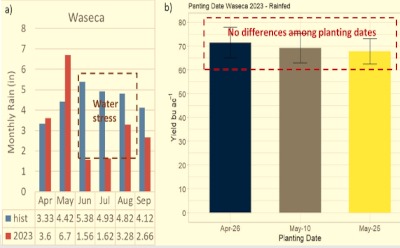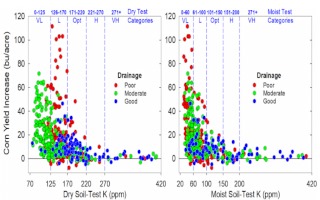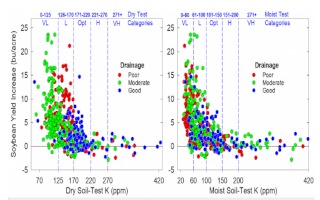By Matthew Gammans and Manni Singh
May is corn planting season in Michigan. In a typical year, less than 6% of Michigan corn acreage is planted before May 1, with around 45% planted by May 15 and over 93% planted by June 1, according to USDA Crop Progress Reports. But, of course, most years are atypical in one way or another. What happens to corn yield when weather gets in the way of on-time planting? This article brings together two potential sources of information to answer this question. We first look at the past relationship between springtime planting progress and Michigan’s statewide average corn yield. We then summarize Michigan corn variety trial results from 2006-2022. This review of evidence concludes that there is little-to-no effect of planting date on yield as long as the corn is planted by mid-May. After June 1, planting delays can cause moderate-to-large declines in corn yield.
Analysis of USDA Crop Progress Reports
Each year, the U.S. Department of Agriculture (USDA) collects data on crop progress in each state. Using data from 1980-2022, we explore the relationship between the pace of planting progress and Michigan’s average corn yield. Figure 1 shows the average planting progress for each decade. The y-axis shows the share of Michigan corn acres that have been planted on or before a specific date. We can see that planting in Michigan typically begins in late April and continues through mid-June. Although there is no clear trend in planting dates over time, we can see that planting during the 2020-2022 period was slower than in previous periods, partly due to unsuitable spring weather.

To evaluate the effect of planting date on average corn yields, Figure 2a shows the estimated effect of a 1% increase in the share of corn acreage planted on or before a specific date on yield (measured in bushels). We can see that changes in planting progress in early May have little to no relationship with statewide average yields. Shifts in progress in late May have small, but significant effects and June planting progress has a large and significant effect on average yield. These estimates imply that having 10% of acreage unplanted in early June leads to a 5 bushel decrease in the statewide average yield, relative to a situation where all fields were planted on June 1. Note that this is the effect on the average statewide yield, the effect on specific unplanted fields is likely to be substantially larger.
A different way to visualize the relationship between planting progress and average statewide yield is shown in Figure 2b. The figure shows the frequency of different date-progress combinations across all years. For example, in mid-April, almost all years had little-to-no planted acres, reflected by the large circles near zero in the mid-April time period. In contrast, there is considerable variation in May 15 planted share across years, with some years having near 100% planted and other years having less than 25% of acres planted on May 15. The color of the points reflects the average detrended yield for all years that had that date-progress combination. This figure is consistent with the idea that while there is not a strong relationship between planting date and yield in April and May, extreme delays like those seen in 2019 can reduce yields considerably.

Analysis of MSU field trial data
Each year, Michigan State University conducts corn variety trials at more than 10 farms across Michigan. For each trial, detailed information on planting date, corn variety, irrigation and soil type is monitored. Ultimately, yield, grain quality and moisture are measured. We can explore this data to investigate the relationship between planting date and yield. We use regression analysis to estimate the effect of a change in planting date on yield, controlling for field characteristics.
One important caveat to these data is that for each site, only one planting date is used, so we cannot compare different planting dates at the same location in the same year. Instead, we look at the same location over different years where different planting dates were used. Ongoing field trials are evaluating the true effect of planting date (i.e., controlling for all other factors) at a given location as well as evaluating other factors that might improve benefits of early-season planting (e.g., hybrid maturity).
Figure 3 shows the results of our current analysis. Yield anomalies—the difference between observed yield and the yield that would be expected based only on year and field characteristics—are plotted in purple. The relationship between planting date (relative to a May 15 planting baseline) and yield is plotted in blue with a 90% confidence interval shown in light blue. The relationship can be interpreted as the effect of shifting from a planting date of May 15 to an alternative date.
Two important findings jump out. First, yields are highly variable. Planting date explains only a portion of the overall variability in yields, with weather, especially summer precipitation, being an important driver of yields. Second, from late April through mid-May there is little relationship between planting date and yield. Starting in early June, delays in planting are associated with large declines in yield. Delaying from June 1 to June 15 is associated with an approximately 10% decline in yield.

Conclusions
For many questions in agricultural production, there are a variety of competing sources of information: field trial data, USDA data, agronomic models and opinions from other growers and agriculturalists. Fortunately, for the relationship between planting date and yield, many of these sources point in the same direction. For much of May, changes in corn planting date do not seem to have large negative effects on realized yield. This wide window for optimal planting is consistent with work the University of Illinois and Purdue University conducted in neighboring states. In late May, there is some evidence that delays cause declines in corn yield. However, planting delays that last into June have the potential to result in significant yield declines. After June 6, consider the effects of planting decisions on eligibility for crop insurance and prevent plant payments. Overall, it is prudent for growers to plant as much corn acres as possible by mid-May, so the next seven to 10 days will be critical for corn planting in Michigan this year.
Source : msu.edu